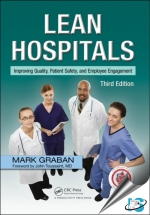Tab Article
Organizations around the world are using Lean to redesign care and improve processes in a way that achieves and sustains meaningful results for patients, staff, physicians, and health systems. Lean Hospitals, Third Edition explains how to use the Lean methodology and mindsets to improve safety, quality, access, and morale while reducing costs, increasing capacity, and strengthening the long-term bottom line.
This updated edition of a Shingo Research Award recipient begins with an overview of Lean methods. It explains how Lean practices can help reduce various frustrations for caregivers, prevent delays and harm for patients, and improve the long-term health of your organization.
The second edition of this book presented new material on identifying waste, A3 problem solving, engaging employees in continuous improvement, and strategy deployment. This third edition adds new sections on structured Lean problem solving methods (including Toyota Kata), Lean Design, and other topics. Additional examples, case studies, and explanations are also included throughout the book.
Mark Graban is also the co-author, with Joe Swartz, of the book Healthcare Kaizen: Engaging Frontline Staff in Sustainable Continuous Improvements, which is also a Shingo Research Award recipient. Mark and Joe also wrote The Executive’s Guide to Healthcare Kaizen.


